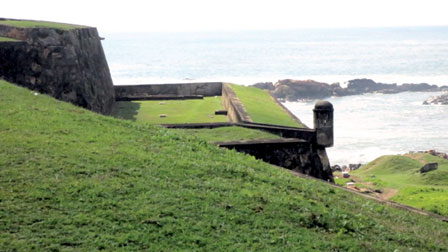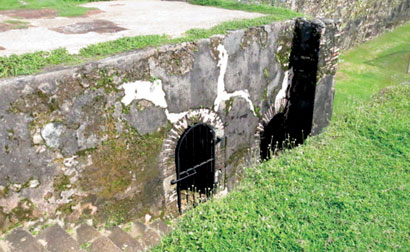Galle’s unique cultural heritage
by W.T.J.S. Kaviratne, Ambalangoda Special Cor.
A tour to Sri Lanka is incomplete if the heritage city of Galle on
the Southern Coast is not included in the travel plan as a destination.
 |
|
The entrance to the
Galle Fort |
Galle is a unique city in the island, rich in diversity. It is an
ideal destination for those who seek adventure, beach holidays and
exploration. Historical, archaeological and literary evidence proves
that inter-religious harmony and multiculturalism had existed in Galle
as a direct influence of the visits of travellers and traders.
In the wake of the tsunami, all religious dignitaries and citizens of
Galle helped each other as a gesture of solidarity. Recovery was speedy
and Galle emerged out of the tsunami debris like the phoenix from the
ashes.
Ancient ports all over the world, since prehistoric times, had played
key roles in transforming the cultural, political, religious and
socio-economic aspects of civilisations.
The Port of Galle played a key role in shaping the political,
cultural, social and educational revival in the entire island. The fame
of Sri Lanka and its exotic scenic beauty, chiefly as a treasure trove
of gems, ivory, peacocks and spices spread through every nook and corner
of the ancient world. The natural harbour there, before the artificial
port was created, was a much sought after destination of seafarers since
ancient times.
Arrival of the Portuguese
On November 15, 1505 during the early hours of the morning, a fleet
of Portuguese ships led by Lorenzo de Almeida, bound for the Maldives,
or when they were chasing Moorish ships blown off course, was forced to
take shelter in the Galle Port.
 |
|
The museum at the Galle
Fort |
Galle was known by different names among seafarers. There are
different legends about these names. On the day of the arrival of the
Portuguese, they had heard a cock crowing. In Portuguese, a cock is
known as Galo and the name Galle is thus believed to have originated.
Point de Galle (Puncto de Galle) was another name given by the
Portuguese.
Some historians believe that the name Galle is derived from the
Sinhala word for rock (Gala) or the cattle fold. In the bygone era, all
merchandise including cinnamon was transported in bullock carts to
Galle.
The well-known Arabian traveller Ibn Batuta, who came from Morocco
during his sojourn in Sri Lanka in 1344 AD, had mentioned in his book
Rihlah that a Muslim captain of a ship called Ibrahim had entertained
him at his residence in Galle or Quali.
In 1587, the Portuguese, having realised the strategic importance of
the location of Galle, was successful in negotiations between Prince
Dharmapala of Kotte in obtaining a limited extent of land for the
construction of a fort by the Galle harbour.
Simple structure
The fortress was a simple structure according to the book on Galle by
Portuguese writer Rubeiro. A moat was constructed in front of the
present day main entrance and a small bridge over the moat facilitated
movement. King Rajasinghe captured this fortress in 1581 -1593, but the
Portuguese forces recaptured it.
 |
|
The Fort overlooking
the Indian Ocean |
In 1619 AD, the Portuguese, preparing for future invasions, built a
fortress of great strength which was known as the Black Fort. More than
26 Portuguese families lived in this fort including provincial Catholic
priests, captains of Portuguese battalions, the manager in charge of the
stores and workers employed by Portuguese masters.
After 53 years of Portuguese reign in the maritime provinces, on
March 8, 1640, under the command of Wilhelm Jacobsz Coster, the Dutch
landed in 12 ships with a battalion of 2,000 soldiers and the Portuguese
fortress was captured in a siege which lasted four days.
A harrowing anecdote reveals how a group of Portuguese women and
children were locked up for safety in an underground vault of the
fortress beneath St. Antonio, while fierce battles were in progress.
All the Portuguese who knew of the whereabouts of the women and
children were killed in battle. There was no one to rescue the women and
children and they died in the chamber due to starvation and suffocation.
After many days, the Dutch invaders discovered the corpses inside the
vault.
After capturing Galle in March 1640, the Dutch maintained the trade
activities in the maritime provinces until 1796 AD. The VOC (Verenigde
Oostindische Compagnie) Dutch East India Company started fortifications
covering 87 acres. In the 17th and 18th centuries, VOC enjoyed a
reputation as the largest trading and shipping company in the world with
a fleet of over 150 ships.
Special attention
During the fortifications done in 1667 AD, the Dutch paid special
attention to the land-side and constructed the Sun, Moon and Star
bastions. They were fully aware of the heavy competition among the
seafaring European nations of the British, French, Danish, Spanish and
Portuguese to capture countries surrounded by the Indian Ocean.
 |
|
A section of the Fort |
On the seaside, Aurora, Utrecht, Triton, Neptune, Klippenburg, Aeolus
and Akerloot bastions were constructed and by 1729, these defences were
completed. The ramparts with watch towers of the fort gradually became
popular promenades for visitors.
The oldest Protestant Church of Sri Lanka, famous for its unique
Dutch architecture is in the Fort known as Groote Kerk, constructed by
Casparus de Jong in 1752 AD as an offering of thanks for the birth of a
daughter. The Bell Tower constructed in 1701, old Dutch Government House
(Queen’s House) dating back to 1683, the New Oriental Hotel, the oldest
hotel in Sri Lanka originally constructed in 1684 and first used as an
administrative office of the Dutch and later registered as an inn in
1863, and the library set up in 1871 are some of the other attractions.
Diplomatic ties
The American Colonel Henry Steele Olcott and Russian H.P. Blavatsky
set sail in a ship known as Ethiopia and reached the Galle Port on May
17, 1880.
Inspired by the Panadura Debate, Colonel Olcott came to Sri Lanka and
embraced Buddhism at the Wijayananda Buddhist Temple, Galle and revived
Buddhist education in Sri Lanka.
Diplomatic ties between Sri Lanka and the USA originated in Galle. In
1850, the first American Commercial Agent John Black began trade between
the two countries. References have been made on Black in Galle and the
trade activities in American documents and journals.
 |
|
The view from the road |
The Galle Port lay on the ancient sea route and trading vessels from
China, Rome, Arabia and Europe called at the Port. In the late 19th
century, steamships from America and Europe travelling to the Far East
stopped at the Galle Port to gather the produce of the island. Ice from
New England ponds was used to chill beverages in Colombo in the era of
sailing ships before the American Civil War.
The arrival of Arabians, Chinese, Portuguese, Dutch and British in
Galle paved the way for a cosmopolitan atmosphere which caused an
indelible impact on the culture, socio-economic conditions, attitudes
and lifestyles of the citizenry. Traces of this influence can be felt
even today in Galle.
Galle was declared a World Heritage Site by UNESCO in 1987. In 1976,
the Municipal Council of Velsen City in the Netherlands approved a
twinning arrangement with the city. The Galle Municipal Council is
responsible for this arrangement in Sri Lanka in close co-operation with
the Netherlands Alumni Association.
Various development projects have been implemented in Galle including
the preservation of Dutch period artefacts in the Fort with the
assistance of the Galle-Velsen Twin City Program. |

